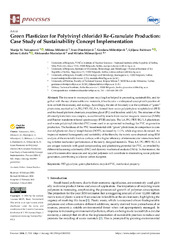Prikaz osnovnih podataka o dokumentu
Green Plasticizer for Poly(vinyl chloride) Re-Granulate Production: Case Study of Sustainability Concept Implementation
| dc.creator | Vuksanović, Marija M. | |
| dc.creator | Milošević, Milena | |
| dc.creator | Dimitrijević, Ivan | |
| dc.creator | Milentijević, Gordana | |
| dc.creator | Babincev, Ljiljana | |
| dc.creator | Gržetić, Jelena | |
| dc.creator | Marinković, Aleksandar | |
| dc.creator | Milosavljević, Milutin | |
| dc.date.accessioned | 2024-04-10T10:22:59Z | |
| dc.date.available | 2024-04-10T10:22:59Z | |
| dc.date.issued | 2024 | |
| dc.identifier.issn | 2227-9717 | |
| dc.identifier.uri | http://TechnoRep.tmf.bg.ac.rs/handle/123456789/7424 | |
| dc.description.abstract | The increase in waste polymer recycling has helped in promoting sustainability, and together with the use of renewable raw materials, it has become a widespread concept with positive effects on both the economy and ecology. Accordingly, the aim of this study was the synthesis of “green” plasticizers, marked as LA/PG/PET/EG/LA, formed from waste poly(ethylene terephthalate) (PET) and bio-based platform chemicals propylene glycol (PG) and levulinic acid (LA). The structure of the obtained plasticizers was complex, as confirmed by results from nuclear magnetic resonance (NMR) and Fourier-transform infrared spectroscopy (FTIR) analysis. The LA/PG/PET/EG/LA plasticizers and waste poly(vinyl chloride) (PVC) were used in an optimized technology for PVC re-granulate production. The hardness of the PVC-based material with “green” plasticizers, in comparison to commercial plasticizer dioctyl terephthalate (DOTP), increased by 11.3%, while migration decreased. An improved material homogeneity and wettability of the fibers by the matrix were observed using SEM analysis of the material’s fracture surface, with a higher efficiency of intermolecular interactions leading to better mechanical performances of the newly designed materials. Thus, LA/PG/PET/EG/LA are unique materials with good compounding and plasticizing potential for PVC, as revealed by differential scanning calorimetry (DSC) and dynamic mechanical analysis (DMA). In that manner, the use of bio-renewable resources and recycled polymers will contribute to diminishing waste polymer generation, contributing to a lower carbon footprint. | en |
| dc.language.iso | en | |
| dc.publisher | MDPI | |
| dc.relation | info:eu-repo/grantAgreement/MESTD/Integrated and Interdisciplinary Research (IIR or III)/43007/RS// | |
| dc.relation | info:eu-repo/grantAgreement/MESTD/inst-2020/200017/RS// | |
| dc.relation | info:eu-repo/grantAgreement/MESTD/inst-2020/200135/RS// | |
| dc.relation | info:eu-repo/grantAgreement/MESTD/inst-2020/200026/RS// | |
| dc.rights | openAccess | |
| dc.rights.uri | https://creativecommons.org/licenses/by/4.0/ | |
| dc.source | Processes | en |
| dc.subject | PET glycolysis | en |
| dc.subject | green plasticizers | en |
| dc.subject | recycled PVC | en |
| dc.subject | mechanical property | en |
| dc.title | Green Plasticizer for Poly(vinyl chloride) Re-Granulate Production: Case Study of Sustainability Concept Implementation | en |
| dc.type | article | en |
| dc.rights.license | BY | |
| dc.citation.issue | 3 | |
| dc.citation.spage | 520 | |
| dc.citation.volume | 12 | |
| dc.identifier.doi | 10.3390/pr12030520 | |
| dc.identifier.fulltext | http://TechnoRep.tmf.bg.ac.rs/bitstream/id/20577/Green_plasticizer_for_pub_2024.pdf | |
| dc.identifier.scopus | 2-s2.0-85189159009 | |
| dc.type.version | publishedVersion |

